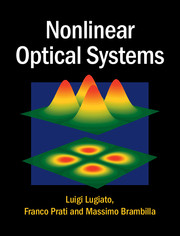Book contents
- Frontmatter
- Dedication
- Contents
- Preface
- Part I Models, propagation, stationary phenomena
- 1 The rate-equation model for the laser
- 2 The interaction of a system of two-level atoms with the electromagnetic field
- 3 The Maxwell–Bloch equations
- 4 Inclusion of the irreversible processes in the atomic equations
- 5 Propagation in irreversible Maxwell–Bloch equations
- 6 Optical nonlinearities. Materials with quadratic nonlinearities
- 7 Optical nonlinearities. Materials with cubic nonlinearities
- 8 Optical resonators. The planar ring cavity. Empty cavity. Linear cavity
- 9 A nonlinear active ring cavity: the ring laser, stationary states
- 10 The adiabatic elimination principle
- 11 A nonlinear passive ring cavity: optical bistability
- 12 Modal equations for the ring cavity. The single-mode model
- 13 Single- and two-mode models
- 14 Nonlinear dynamics in Fabry–Perot cavities
- 15 Inhomogeneous broadening
- 16 The semiconductor laser
- 17 Lasers without inversion and the effects of atomic coherence
- Part II Dynamical Phenomena, Instabilities, Chaos
- Part III Transverse optical patterns
- Appendix A The Routh–Hurwitz stability criterion
- Appendix B Calculation of the oscillatory instability boundary
- Appendix C Coefficients of the characteristic equation (20.20)
- Appendix D Derivation of equations (20.27) and (20.28)
- Appendix E Coefficients of equations (20.60) and (20.61)
- Appendix F The exact boundary of the Risken–Nummedal–Graham–Haken instability
- Appendix G Nonlinear analysis of the roll solution
- References
- Index
12 - Modal equations for the ring cavity. The single-mode model
from Part I - Models, propagation, stationary phenomena
Published online by Cambridge University Press: 05 March 2015
- Frontmatter
- Dedication
- Contents
- Preface
- Part I Models, propagation, stationary phenomena
- 1 The rate-equation model for the laser
- 2 The interaction of a system of two-level atoms with the electromagnetic field
- 3 The Maxwell–Bloch equations
- 4 Inclusion of the irreversible processes in the atomic equations
- 5 Propagation in irreversible Maxwell–Bloch equations
- 6 Optical nonlinearities. Materials with quadratic nonlinearities
- 7 Optical nonlinearities. Materials with cubic nonlinearities
- 8 Optical resonators. The planar ring cavity. Empty cavity. Linear cavity
- 9 A nonlinear active ring cavity: the ring laser, stationary states
- 10 The adiabatic elimination principle
- 11 A nonlinear passive ring cavity: optical bistability
- 12 Modal equations for the ring cavity. The single-mode model
- 13 Single- and two-mode models
- 14 Nonlinear dynamics in Fabry–Perot cavities
- 15 Inhomogeneous broadening
- 16 The semiconductor laser
- 17 Lasers without inversion and the effects of atomic coherence
- Part II Dynamical Phenomena, Instabilities, Chaos
- Part III Transverse optical patterns
- Appendix A The Routh–Hurwitz stability criterion
- Appendix B Calculation of the oscillatory instability boundary
- Appendix C Coefficients of the characteristic equation (20.20)
- Appendix D Derivation of equations (20.27) and (20.28)
- Appendix E Coefficients of equations (20.60) and (20.61)
- Appendix F The exact boundary of the Risken–Nummedal–Graham–Haken instability
- Appendix G Nonlinear analysis of the roll solution
- References
- Index
Summary
In the previous chapters we considered the Maxwell–Bloch equations with the boundary condition appropriate for a unidirectional ring cavity and calculated the stationary solutions for laser and optical bistability, respectively. Next, we showed that the exact stationary solutions simplify appreciably in the low-transmission limit.
In this chapter we want, first of all, to apply the low-transmission approximation on the dynamical equations directly, beyond the stationary case. We start from the Maxwell–Bloch equations (4.35)–(4.37) and the boundary condition (8.36). The latter is complex and includes the retardation Δt and some parameters such as the transmissivity and reflectivity coefficients T and R, the input field y and the cavity detuning δ0.
We introduce a transformation of the coordinates z and t and a transformation of the variables F and P [121–123]. As a result, the boundary condition reduces to a simple periodic boundary condition, and the electric-field equation incorporates the parameters which previously appeared in the boundary condition. The virtue of the periodic boundary condition is that it allows one to expand the electric field in terms of modal amplitudes and to recast the field equation in the form of a set of time-evolution equations for the modal amplitudes. All of this is shown in Section 12.1.
In Section 12.2 we apply the low-transmission approximation and the Maxwell–Bloch equations assume a form that is a generalization of a set of equations commonly used in the literature to describe the ring laser [124]. Together with the Bloch equations for the atomic variables, the modal equations provide a model that lends itself ideally to a numerical resolution of the equations.
In Section 12.3 we show that, if we assume that only the resonant cavity mode is active, this model reduces to a simple single-mode model consisting in three coupled ordinary differential equations, which will be analyzed in Part II of this book. Next, in the same section we derive the single-mode model in a more direct way, without passing through the multimodal equations.
- Type
- Chapter
- Information
- Nonlinear Optical Systems , pp. 126 - 134Publisher: Cambridge University PressPrint publication year: 2015



